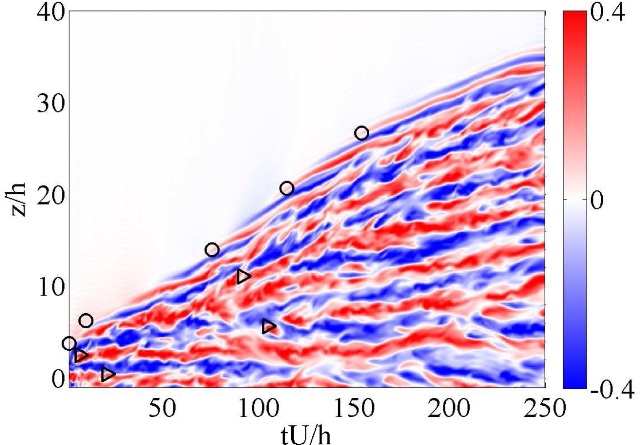
Effects of poroelastic materials on turbulent flow structures
with Fredrik Lundell and Shervin Bagheri
Flows over slender, deformable and dense structures are ubiquitous in both nature and technological applications, ranging from the atmospheric flow over trees to the flow over the over the skin of organisms. In order to create a fundamental understanding of how poro-elatic surface can be used for flow control purposes, our work focuses on the behaviour of wall-bounded turbulent flows over fibrous poro-elastic surfaces. We fabricate the coatings using Off-Stoichiometry-Thiolene-Epoxy (OSTE+) polymers and multidirectional UV-lithography which enables us to design arrays of flexible pillars with various geometrical parameters (aspect ratio, pitch, inclinaison, etc.). We assess the effects of these coatings on an overlying low-Reynolds number turbulent flow using a water-table facility and PIV measurements. In particular, we focus on the modification of near wall turbulent structures in both space and time due to the presence of the poro-elastic coatings.
Transition to turbulence in plane Couette flow
PhD Supervisor: Romain Monchaux
This work focuses on the study of the laminar-turbulent coexistence in plane Couette flow, the flow sheared between two walls where a subcritical transition to turbulence occurs. We jointly use an experimental setup and direct numerical simulations which allow us to have access to visualizations and velocity fields when both laminar and turbulent states coexist.

Snapshots of a spot growing around a bead during a step experiment (sudden increase at t = 0 of Re from 0 to 403). Times are given in unit of h/U.
We show for the first time in a plane Couette experiment the presence of large scale flows in the vicinity of turbulent fronts during the turbulence expansion. We quantify them and show a correlation between their dynamics and the one of turbulent spot. We then focus on the turbulent spot growth in an initially laminar flow. A new global mechanism is identified which complements the usually evoked local mechanism.

Ux space-time diagram for a DNS at Re = 380. Nucleations of streak inside (▷) and outside (o) of the spot are labelled. Only half the spot is presented in the spanwise direction.
The study of the growing rate of both mechanisms allows one to get a more comprehensive view of the spot expansion along the spanwise direction which occurs via nucleations of velocity streaks. We also establish a link between the dynamics of the spot fronts, the one of the edge vortices and the one of large scale flows. We eventually study the turbulent spot growth along the streamwise direction by way of spot front velocities analysis as a function of time and Reynolds number. The turbulent spot shape can then be understood as the result of the effect of the mechanisms acting along both directions.
Control of a road vehicle wake
* Master thesis
I studied the control of a road vehicle wake to reduce drag with passive and active control. Both numerical and experimental studies have been carried out.